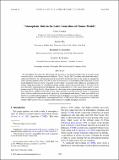| dc.contributor.author | Covey, Curt | |
| dc.contributor.author | Dai, Aiguo | |
| dc.contributor.author | Marsh, Daniel R. | |
| dc.contributor.author | Lindzen, Richard Siegmund | |
| dc.date.accessioned | 2015-01-05T20:03:14Z | |
| dc.date.available | 2015-01-05T20:03:14Z | |
| dc.date.issued | 2014-06 | |
| dc.date.submitted | 2014-02 | |
| dc.identifier.issn | 0022-4928 | |
| dc.identifier.issn | 1520-0469 | |
| dc.identifier.uri | http://hdl.handle.net/1721.1/92661 | |
| dc.description.abstract | For atmospheric tides driven by solar heating, the database of climate model output used in the most recent assessment report of the Intergovernmental Panel on Climate Change (IPCC) confirms and extends the authors’ earlier results based on the previous generation of models. Both the present study and the earlier one examine the surface pressure signature of the tides, but the new database removes a shortcoming of the earlier study in which model simulations were not strictly comparable to observations. The present study confirms an approximate consistency among observations and all model simulations, despite variation of model tops from 31 to 144 km. On its face, this result is surprising because the dominant (semidiurnal) component of the tides is forced mostly by ozone heating around 30–70-km altitude. Classical linear tide calculations and occasional numerical experimentation have long suggested that models with low tops achieve some consistency with observations by means of compensating errors, with wave reflection from the model top making up for reduced ozone forcing. Future work with the new database may confirm this hypothesis by additional classical calculations and analyses of the ozone heating profiles and wave reflection in Coupled Model Intercomparison Project (CMIP) models. The new generation of models also extends CMIP's purview to free-atmosphere fields including the middle atmosphere and above. | en_US |
| dc.description.sponsorship | United States. Dept. of Energy. Office of Science (Lawrence Livermore National Laboratory. Contract DE-AC52-07NA27344) | en_US |
| dc.language.iso | en_US | |
| dc.publisher | American Meteorological Society | en_US |
| dc.relation.isversionof | http://dx.doi.org/10.1175/jas-d-13-0358.1 | en_US |
| dc.rights | Article is made available in accordance with the publisher's policy and may be subject to US copyright law. Please refer to the publisher's site for terms of use. | en_US |
| dc.source | American Meteorological Society | en_US |
| dc.title | Atmospheric Tides in the Latest Generation of Climate Models | en_US |
| dc.type | Article | en_US |
| dc.identifier.citation | Covey, Curt, Aiguo Dai, Richard S. Lindzen, and Daniel R. Marsh. “Atmospheric Tides in the Latest Generation of Climate Models.” J. Atmos. Sci. 71, no. 6 (June 2014): 1905–1913. © 2014 American Meteorological Society | en_US |
| dc.contributor.department | Massachusetts Institute of Technology. Department of Earth, Atmospheric, and Planetary Sciences | en_US |
| dc.contributor.mitauthor | Lindzen, Richard Siegmund | en_US |
| dc.relation.journal | Journal of the Atmospheric Sciences | en_US |
| dc.eprint.version | Final published version | en_US |
| dc.type.uri | http://purl.org/eprint/type/JournalArticle | en_US |
| eprint.status | http://purl.org/eprint/status/PeerReviewed | en_US |
| dspace.orderedauthors | Covey, Curt; Dai, Aiguo; Lindzen, Richard S.; Marsh, Daniel R. | en_US |
| dc.identifier.orcid | https://orcid.org/0000-0002-7520-7028 | |
| mit.license | PUBLISHER_POLICY | en_US |
| mit.metadata.status | Complete | |

